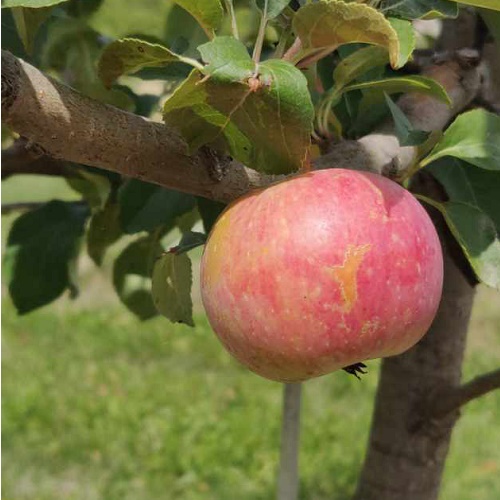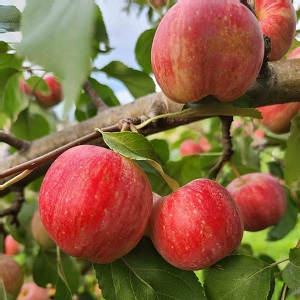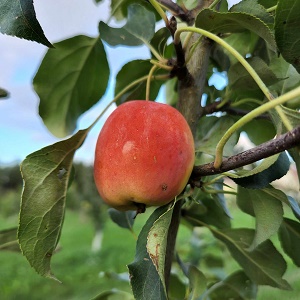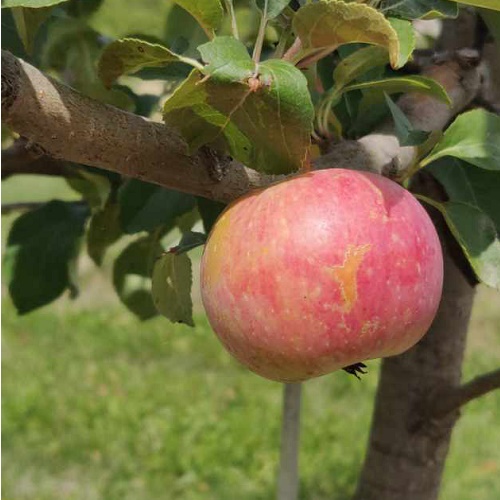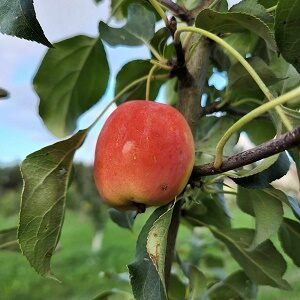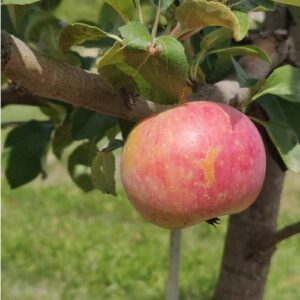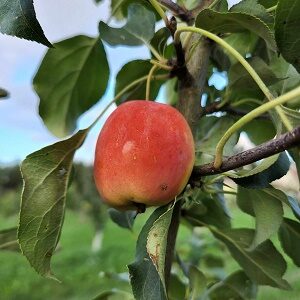Crabapples
The reasons for planting a crabapple tree are many and varied. Commercial orchardists value the pollination benefit of their extravagant blooming, while some homeowners simply enjoy the fragrant and elegant beauty of the spring blossom show. Others have discovered the unexpected pleasurable eating experience some varieties provide. A renewed interest in cider making is also fueling a fresh appreciation for the crabapple contribution. What’s more, their innate cold hardiness and naturally compact form opens the opportunity for almost anyone to plant one.
1.25-2m (4-6') bareroot trees
Crabapple : CHESTNUT Large Semi-Dwarf (B118)
$49.95
Fabulous, complex flavour in a golf ball-sized fruit! Chestnut has been known to win apple taste tests with its crisp, sweet yellow flesh that is nutty with a hint of vanilla. Reddish bronze fruit hangs on the tree long after ripening and is ideal for dessert, cider, pickling or sauce. With large, aromatic white blossoms, this disease resistant variety makes a great ornamental landscaping addition.
SEMI-FERTILE* | ZONE 3 | HARVEST: EARLY SEPT.
Rootstocks
G41 Dwarf
(2.5-3.1m/8-10ft)
G935 Small Semi-Dwarf
(3.25-4m/10-13ft)
G969 Small Semi-Dwarf
(3.25-4m/10-14ft)
G30 Semi-Dwarf
(3.6-5m/12-16ft)
G890 Semi-Dwarf
(3.6-5m/13-16ft)
Pollenator definitions
Some trees and many berry plants are SELF-FERTILE ̶means the insect pollinators or even the wind can pollinate the blossoms without the need of a second tree.
NEEDS A POLLENIZER ̶ means another tree of the same type or kind but a different variety must be blooming nearby at the same time.
EXAMPLE A Liberty apple and a Wealthy apple can cross-pollinate. Two trees of the same variety ie: ̶ 2 Wealthy apples, cannot cross pollinate because they are genetically identical.
Other trees are marked as SEMI-FERTILE. These will set fruit without a second tree. However they will often bear more, and sometimes larger fruit if another variety of the same kind of tree is nearby.
You can select 2 different trees of the same kind marked as NEEDS A POLLENIZER or plant one of those along with one SELF-FERTILE or one SEMI-FERTILE. Also consider ripening times ̶ a Goldrush apple might not start blooming before a Pristine is finished.
NEEDS A POLLENIZER ̶ means another tree of the same type or kind but a different variety must be blooming nearby at the same time.
EXAMPLE A Liberty apple and a Wealthy apple can cross-pollinate. Two trees of the same variety ie: ̶ 2 Wealthy apples, cannot cross pollinate because they are genetically identical.
Other trees are marked as SEMI-FERTILE. These will set fruit without a second tree. However they will often bear more, and sometimes larger fruit if another variety of the same kind of tree is nearby.
You can select 2 different trees of the same kind marked as NEEDS A POLLENIZER or plant one of those along with one SELF-FERTILE or one SEMI-FERTILE. Also consider ripening times ̶ a Goldrush apple might not start blooming before a Pristine is finished.
Other products in this zone
Growing Tips
Apple Growing Tip
Besides selecting the most disease resistant varieties, there are
a few simple things to do to have better apples.
- Fertilize under the outer edges of your trees. There are no feeder roots next to the trunk. A well fed tree stays healthier. (Adequate calcium in the soil also helps so that apples keep longer.)
- Pick up fallen fruit and compost, dispose of, or feed to livestock (where possible).
- Rake up leaves in the fall and compost them away from the orchard.
- Prune trees to encourage light and air to reach the inside of the tree.
- Provide bird nesting sites near your orchard. A variety of orchard companion type plants will attract native pollinator insects and also encourage birds to come and eat insect pests.
